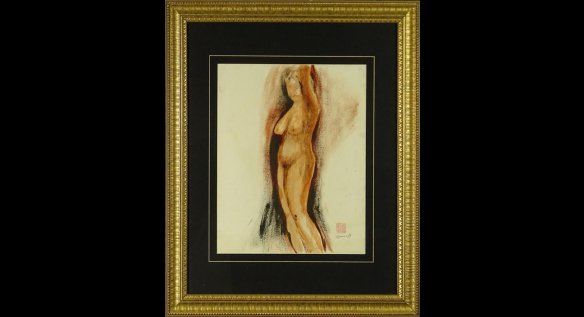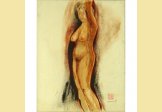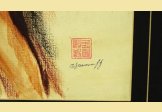Standing Nude
| Artist | : | Alexander Evgenievich Yakovlev |
| Medium | : | Works on paper (Chalk/Pen/Graphite) |
| Size unframed | : | 15.25"/19.25" |
| Size framed | : | N/A |
| Signature Info | : | Hand Signed |
| Frame Info | : | Not Framed |
| Condition | : | Very Good |
| Year | : | Unknown |
Description
This is a very rare Original Sanguine on paper, by Alexander Evgenievich Yakovlev.
Alexander Evgenievich Yakovlev, Russian (1887-1938) Original work - Sanguine on paper, "Seated Nude". Signed lower right, alongside artist's stamp. Good condition. Measures 19-1/4" H, 15-1/4" W (sight), frame measures 32" H, 26" W. Rare opportunity to acquire an original, signed and stamped work by this artist, with good provenance. Acquired from the collection & estate of Robert Eigelberger, Casa Phippsberger, Palm Beach, Florida, USA.
Artist: Alexander Evgenievich Yakovlev
Title: "Standing Nude"
Medium: Sanguine on Paper
Year: Unknown
Edition: Original, unique work
Signature: Hand signed by the artist, with artist's stamp
Provenance: Acquired from the collection & estate of Robert Eigelberger, Casa Phippsberger, Palm Beach, Florida, USA
FAMOUS ARTWORKS
“Pierrot and Harlequin,” 1914
“Violinist,” 1915
“Beijing Opera,” 1918
“Les Autos Dans Le Desert,” 1924
“The Kuli Kuta Dance, Niamey,” 1926
“View of Anthéor,” 1927
“Lemons,” 1929
“Nudes Bathing,” 1929
“Portrait of Tien Po,” 1931
“Afghans,” 1932
“Palmyra,” 1933
“Conversation in Capri,” 1936
Alexander Evgenievich Yakovlev (Rus. 1887-1938)
Occupation: Painter, Draftsman, Etcher, Designer
Movement: Neoclassicism
Education: Academy of Fine Arts, St. Petersburg
Alexander Yakovlev was a Russian Neoclassical painter who contributed deeply to the expansion in style and imagery in Neoclassical painting in the early 20th century. He travelled widely in the Middle and Far East, as well as in Central Africa, participating in and advising three different expeditions in his lifetime. By the time he died in 1938, Yakovlev had been much awarded, and was one of the few émigré artists whose work was routinely exhibited in the USSR during his lifetime.
Origins and Student Life
Alexander Evgenievich Yakovlev was born in June 1887 to wealthy and educated parents in St. Petersburg, Russia. His father Yevgeny invented the Russian internal-combustion engine and was the owner of the first oil and gas-engine factory in Russia. His mother, Sofia Kuzmina, was the first woman to hold a doctorate in Mathematical Sciences in Russia. In keeping with his parents, Yakovlev attended the Imperial Academy of Fine Arts in St. Petersburg from 1905 to 1913, training under the famous illustrator and stage designer Dmitry Kardovsky. He illustrated for a number of art magazines as a student, and in 1912, he joined the Mir Iskusstva art movement.
Miriskusniki
“Mir Iskusstva” was a magazine and an art movement begun at the turn of century by the famous art critic and stage designer Alexandre Benois, the painter Léon Bakst, and the ballet producer Sergei Diaghilev. Followers of the movement, or ‘miriskusniki,’ sought to conserve and understand the art that came before them, particularly traditional folk art, and rejected what they saw as the utilitarian aesthetic of modern industrial society.
At the time, Yakovlev was trying to aesthetically reconcile elements of Renaissance and Rococo painting with popular Russian graphic art. It was a modernist attempt to marry elements of high art and popular art. One of the most important values of Mir Iskusstva, was to bring art into the lives of everyday people: “Man With Monkey,” painted in 1915, is a good example of Yakovlev’s efforts. His self-portrait with Vasiliy Shukhaev, “Pierrot and Harlequin” painted in 1914, and “The Violinist” painted the following year are iconic of this period. The neat lines, smooth shapes and meticulously precise figures characterized his work to come.
Growing Renown
In 1912, Yakovlev’s painting “On Academic Dacha” brought him to the attention of critics and art lovers at the Baltic Exhibition in Sweden; even Alexander Benois had praise for his work. In 1913, he graduated as an Artist from the Imperial Academy, and his paintings “Bathing” and “In a Bathhouse” won him a scholarship to study painting in Italy and Spain. He returned to St. Petersburg in 1915 and entered a period of prolific activity. Even though his work was critically well-received, it was rejected by the Academy of Fine Arts. Over the next two years, he sketched a large number of drawings in chalk, lectured on architect courses for women and frescoed a cabaret in St. Petersburg and a manor in Moscow. He even started the St. Luke Guild of Painters movement, traditionally honoring the patron saint of artists.
Travels Far and Wide
In 1917, Yakovlev won a scholarship to study painting in the East. For the next two years, Yakovlev traveled through the Mongolia, China and Japan, studying, painting and documenting. During this time, the Russian Revolution made it impossible for him to return to Russia, and he settled in Paris in 1919. Through 1924-25, he traveled in the Sahara desert and through Equatorial Africa with an expedition organized by the Citroen automobile company. And again, in 1931-32, Yakovlev traveled through the Middle East and Central Asia, visiting Syria, Iran, Afghanistan, Mongolia and China with Citroen, serving also as an adviser to the expedition.
The significance of Yakovlev’s travels show in his work. His drawings, etchings and paintings represent his experiences, but his romance with pure forms and for folk cultures express an enduring vitality in his paintings. They allowed the viewers of the time a window into the lives of people and cultures that academia could not. His paintings of Africa, for example, made such an impact that in 1926, he was awarded the Legion of Honor by the French. Despite having emigrated, his relations with Russia remained strong. In 1928, the Academy of Fine Arts in Moscow even organized a solo exhibition of Yakovlev’s work. His reputation simply as an artist and traveler held him above the tumultuous world of politics.
The Later Years
In 1934, Yakovlev was invited to be the Director of Painting at the Museum of Fine Arts in Boston. He spent the next three years in the United States before returning to Paris. His work over the last few years of his life began to show more Expressionistic attitudes. While still characteristically well-formed, his figures show a blurring of particular objective details, making more room for the artist’s inner reality to express itself.
He died in Paris from a failed surgical operation in the summer of 1938, at the age of 51.
MUSEUMS / COLLECTIONS
National Gallery of Art, Washington D.C.
The State Hermitage Museum, St. Petersburg
Philadelphia Museum of Art, Philadelphia
BOOKS / PUBLICATIONS
“Le Theatre Chinois (with paintings, sketches and crayon drawings by Alexandre Jacovleff)” by Chu Chia-Chien and Alexandre Jacovleff





